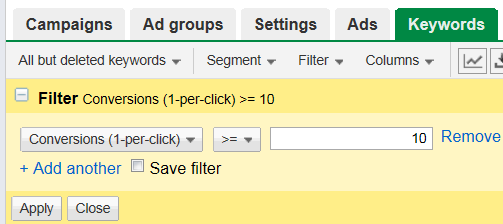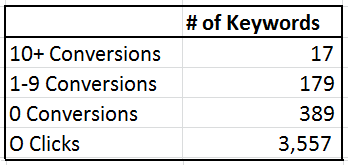Managing PPC Through The Fog Of Long Tail Keywords
PPC managers over the years have always struggled with the right number of keywords to have in their accounts. Should you build out a big inventory of long tail keywords, or keep your campaigns neat and tidy, with fewer terms that account for most of the volume? Honestly, I’d say that most accounts I’ve seen, and indeed, many […]
PPC managers over the years have always struggled with the right number of keywords to have in their accounts. Should you build out a big inventory of long tail keywords, or keep your campaigns neat and tidy, with fewer terms that account for most of the volume?
Honestly, I’d say that most accounts I’ve seen, and indeed, many I’ve built over the years are much more complex and unwieldly than they need to be.
In general, I’d argue that for most companies, AdWords accounts with smaller keyword inventories can perform just as well as accounts using larger keyword inventories, because they are easier to understand and manage and more likely to become refined over
time.
Using brute force to build out long tail lists of tens of thousands of keywords seems like a powerful technique, but the larger the account, the harder to refine, because
all the mundane tasks associated with manipulating, and reporting on super large keyword lists is mind-numbing.
If your mind is numb, how can you possibly do all the more interesting and potentially more powerful tasks like writing truly click-worthy new ads, or working on your geo-targeting, sitelinks, landing pages and other more intellectually stimulating tasks?
So, in my opinion, smaller is better, but whether you choose to build out a gigantic long tail, or stay more conservative, in either case, it is important to know if your long
tail keywords are improving your account performance or simply costing you money.
Long Tail Overhead
The first step is to determine the actual cost of your long tail keywords. For now, let’s simply define long tail keywords as those keywords in your account that have low search volume and have relatively few impressions, clicks and conversions associated with them.
The head term keywords, on the other hand, are those which have lots and lots of action. These are oversimplified definitions, but I think they will help illustrate the concept.
Head terms are easier to optimize for because the results are easier to interpret. For example, if a keyword gets 3000 clicks and 500 conversions on one version of an ad, and it gets ~3000 clicks and 100 conversions for a different ad, you can be very confident knowing that the first ad leads to better results.
The problem with the long tail is the exact opposite. Because no single keyword gets very much volume, it is impossible to evaluate its performance.
If you have 5000 long tail keywords and each one gets less than 10 clicks, you can’t make decisions on whether any individual keyword is performing well or not, because you don’t have enough data to make a decision.
Perhaps a few of those clicks lead to conversions, but even then you are stuck with insufficient data to make a case to keep the keyword in your inventory. The same is true if a keyword with 10 clicks has 0 conversions. You can’t kill the keyword based on its performance because you do not have enough data.
Even if you let more time elapse, the problem will always exist that most of your long tail keywords are never going to generate enough volume for you to make a decision
to keep them or discard them. You can’t prove any keyword is good and you can’t prove any keyword is bad.
However, you can evaluate them as a whole, and see how much overhead they are adding to your overall conversion costs.
You can do this within AdWords by running a few keyword reports, and applying filters to drill in on the data you want to see. In this case, we’ve run a report to look at the impact of keywords with 10 or more conversions, keywords with one or more but fewer than 10, and then for keywords that have registered no conversions at all.

AdWord Keyword Report with Filters
When you apply the filter, you can see the performance metrics associated with your filter at the bottom of the AdWords report screen:
Running each of the filtered reports, we can summarize the data as follows:

Long Tail Keywords add to Overall Campaign Cost
The productive head terms (10+ conversions) are bringing half of all conversions. The productive long tail, (1-9 conversions) brings in 40% and the non-productive long tail, brings no conversions and accounts for 9.25% of all ad spend. In this case, the long tail overhead adds about $4 to the cost of each conversion.
So, a question that one might ask is why not simply delete the non-productive long tail keywords and keep the productive ones? Because long tail keywords are by definition keywords that don’t have enough data to informed decisions, whether that’s to keep the productive long tail keywords or to discard the non-productive ones.
The point of this example is that if you are going to use a long tail strategy, you have to embrace the uncertainty that lies within the fog of long tail keyword inventory
and get used to the reality that there is a direct overhead cost associated with maintaining a long tail inventory. An acceptable overhead is one that keeps your
overall campaigns profitable, while extending your reach with your search keyword.
However, one thing you can do is watch how the long tail overhead varies by month. If the overhead is growing, you will want to take a good look at your long tail keywords, bids and ads.
Identifying Useless Keywords
From these same keyword reports, you can also identify keywords that are not getting any impression at all. At the bottom right of that same report screen, you can see the number of keywords associated with each filtered keyword segment in your account.
- Long Tail can contain lots of deadwood keywords
For this example, we also looked at keywords that were producing no clicks at all. In this case, the long tail contains 10x more keywords that are complete deadwood than keywords that are attracting clicks and conversions, as summarized here:

Long Tail inventory can contain a lot of dead wood keywords
Even when pursuing a long tail keyword strategy, it is still a good idea to get rid of completely useless keywords that are only taking up space in your account.
Opinions expressed in this article are those of the guest author and not necessarily Search Engine Land. Staff authors are listed here.
Related stories

